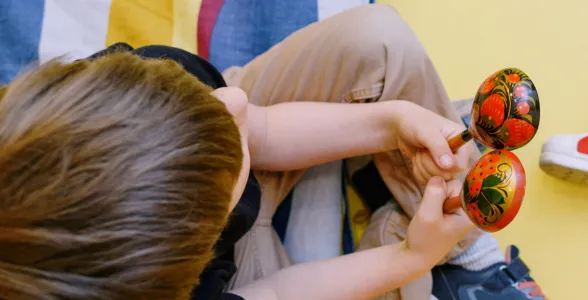
Using music with children with SEN
Our Music Therapist, Emma recently wrote an article for SEN Magazine, we have pulled some extracts from it below but you can read the full article here.
We all have unique connections and associations with music. Music is present from the beginnings of life in our earliest mother-infant vocalising interactions. Music has the power to bring about similar physical and emotional responses in different people at the same time. It is capable of both intensifying a certain emotion and coordinating the way in which a group of people should move together (we’ve all done the Macarena at some stage). Music can express, articulate, and channel feelings that cannot be put into words, bypassing the need for language, and it is this part of music that is invaluable, particularly when working with pre-verbal or non-verbal communities.
- The experience of live music-making within a responsive, familiar relationship, attuned to a person’s sounds and gestures, can be extremely beneficial for development.
- Unlike recorded music, live musical interaction can draw out a person’s voice and personality, enabling SEN staff to respond in the moment to the quality of the individual’s engagement
Social Interaction and Communication
- Singing can be used in SEN to attune, match, mirror sounds or vocalisations to reinforce or bring awareness to an individual’s voice.
- Using familiar songs can be a simple way to stimulate speech.
- A simple turn taking activity using a small instrument, such as a shaker or bell can encourage social interaction.
- Use a melody that is familiar to you and change the lyrics to instruct others to pass an instrument around the group. This offers opportunity to observe many different skills including gross motor skills, memory skills and learning skills
Cognition/Learning Skills
- Music can
- support attention and focus,
- enhance short term and working memory
- provide opportunities to encourage decision making and planning.
- increase motivation for learning by making it fun
Physical/Motor skills
- Using melody and rhythm can support to target and reinforce gross and fine motor skills as well as supporting balance, coordination and control of movements.
- By maintaining a steady beat on a drum, attuned to an individual, it can support connection to bodily rhythms, regulate and even synchronise movement to rhythm or pulse. By matching, rhythm can reinforce a movement.
Emotional wellbeing
- Music can be used to explore individual emotional expression and creativity.
- It can be a safe medium to explore more difficult emotions and can be used to learn about self-regulation.
- This can promote a level of self-awareness and therefore increase self-esteem and confidence.
Playlists
Creating playlists can be an effective way to both learn about an individual and provide a means of energising, relaxing, motivating or supporting concentration. Music preference is personal so finding what works and connects with an individual is very important. A relaxation playlist should include music that is predictable, steady in pulse and may have repeating themes or sections. If you want to motivate, you want music that holds your attention with patterns that you connect with and make you want to move.
Musicality is fundamentally innate and is such a unique human trait. We all have connections and feelings around our own musicality. But using it can open channels of communication and expression that you may not have realised possible.
To find out more about our work in schools, please do get in touch.
Support our Work
Help us to provide Music Therapy to the most vulnerable and isolated members of our society
Donate here

.webp)

.webp)
.png)